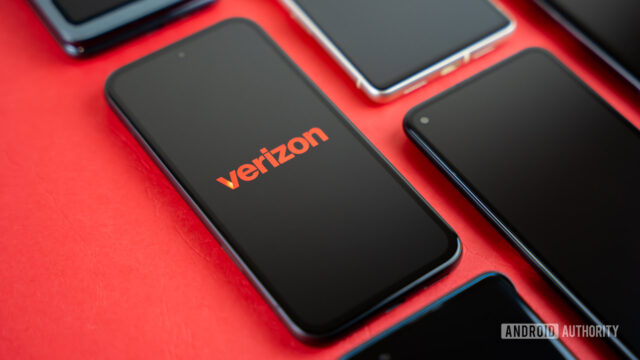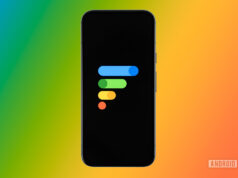Edgar Cervantes / Android Authority
You may be under the impression prepaid carriers always have dramatically slower speeds due to poor priority levels over the big carriers. This can certainly be true, but Verizon offers its highest priority levels to a surprising number of partner networks. In contrast, AT&T only gives its best priority to its own in-house plans.
You’ll get the highest-priority data Verizon provides if you sign up for one of the following prepaid alternatives:
- Visible (Sign up now!): This Verizon-owned prepaid provider offers truly unlimited data, and Verizon’s highest priority is available in the Plus package for just $35 a month right now (with a 2-year price lock guarantee).
- Total Wireless (Sign up now!): With plans starting as low as $25 a month for 5 lines, Total offers great family plans and more.
- US Mobile (Sign up now!): Not only do you get the fastest Verizon priority, but you can also switch to AT&T or T-Mobile’s network if needed!
- MobileX (Sign up now!): Whether you want a basic mobile plan or per-gig access to Verizon’s priority speeds, MobileX has you covered.
- Spectrum Mobile (Sign up now!): Offers two unlimited data packages with the same priority level as Verizon’s mid- and high-tier postpaid plans, starting at $30 a month.
- Xfinity Mobile (Sign up now!): Also offers two options with high-priority data, though pricing starts a bit higher at $40 a month.
Keep in mind that some of these carriers only offer the highest priority for specific plans, which we’ll delve into a bit deeper below. Let’s start by looking at QCI levels.
Understanding QCI levels
A QCI stands for Quality of Service Class Identifier. This is basically a way to prioritize different types of data across a mobile network. Typically, lower QCI numbers indicate higher priority, though this isn’t always strictly the case.
Verizon uses QCI 8 for its consumer postpaid plans outside of its entry-level plan. Verizon’s basic plan has a QCI 9, the same speed you’d get with most prepaid carriers on Verizon’s network. Meanwhile, all the carriers listed above offer a QCI of 8, giving you better performance than Verizon’s cheapest postpaid plan.
Considering some of these plans are much cheaper than Verizon’s postpaid service, what’s the catch? For one, not all of these plans offer unlimited QCI 8 priority. For example, Spectrum Mobile’s plans only provide this priority until you reach a certain cap — varying from 30GB to 50GB, depending on the plan. After this, you’ll typically see speeds drop well below 1 Mbps for the remainder of the month.
Be aware I’ve had personal experience with Visible, US Mobile, and Total Wireless and can attest to the claim that you’ll get the same priority as Verizon postpaid. I also highly recommend all three, though I definitely skew more towards the first two options. While I can’t personally vouch for the rest, I stand by my research and also recommend checking out the very helpful QCI list from /NoContract on Reddit.
What other sacrifices will you make with prepaid?
The exact trade-offs will vary depending on the carrier, but generally, you can expect the following:
- Options for phone financing and device plans may be more limited.
- Customer service is typically less robust (though not always).
- You’ll need to be a bit more tech-savvy when problems arise — or have someone tech-savvy to lean on.
- Free phone promotions are rare, though the lower monthly rates usually make up for it.
- Streaming perks and other bonuses are less common in the prepaid tier.
The takeaway here? Prepaid networks require a bit of a DIY approach to troubleshooting, but if you can get past that, you can save a lot in the long run. If none of these trade-offs are dealbreakers, keep reading! Below, we’ll dive into each of the six options to help you find the perfect fit for staying on Verizon’s network while saving some cash.
Visible Plus

Edgar Cervantes / Android Authority
Pros:
- Verizon’s fastest speeds for just $35 a month.
- Free smartwatch service included!
- International perks, including 2GB of data a day in Canada and Mexico.
Cons:
- Limited online-only customer support means you’ll need to be hands-on.
- No $10 add-on perks like Verizon’s postpaid plans.
- Financing and device protection options are more limited than postpaid.
While Visible Basic has a QCI of 9, similar to Verizon’s entry-level myPlan Unlimited Welcome plan, Visible Plus offers the same speeds and priority as Verizon’s myPlan Plus or Ultimate. However, be aware that once you use 50GB of data, your priority will drop to the same level as the Basic plan for the remainder of the month.
Visible is an excellent way to save money while enjoying a postpaid Verizon experience. The setup process is typically a breeze, even for those who consider themselves less tech-savvy. If you can download an app and follow the instructions, you’re good to go. That said, when issues arise with the network, you’ll need to be more hands-on than you would with Verizon’s postpaid service.
There’s no in-store assistance or phone support; customer service is entirely online. The good news is that, despite its shortcomings, there’s an active online community on Reddit where you can ask questions and find solutions.
Total Wireless

Pros:
- Family plans with unlimited priority data for as little as $25 a month per line for five lines
- Perks like Disney Plus help this carrier stand out
- Robust selection of devices across the flagship, mid-range, and budget segments
Cons:
- Less robust customer service than postpaid, though you do have both online and phone options
- Financing and protection plan options exist, though again your terms might be better with postpaid
Total Wireless is yet another Verizon-owned service, though unlike Visible, its goal is to provide an experience with some of the perks and extras you’d typically get with postpaid. The base unlimited plan here doesn’t have as high of prioritization as Verizon’s postpaid plans, but thankfully its other two unlimited plans do. In most cases, I recommend the Total 5G Plus Unlimited plan, as it offers unlimited hotspot access and ad-free Disney Plus to sweeten the deal for only slightly more.
Family plans are where the biggest savings can be found. You can get unlimited priority data for as little as $25 a month per line for five lines, though the same plan costs $60 a month for a single line.
As with pretty much every prepaid carrier on this list, this can be a great way to save money. However, if a problem arises, you’ll need to be comfortable troubleshooting directly if customer service can’t resolve the issue. Total Wireless offers more robust customer service than Visible, but it is still limited by the lack of brick-and-mortar locations. Want to learn more? Check out our Total plans guide.
US Mobile

Edgar Cervantes / Android Authority
Pros:
- Verizon’s fastest speeds starting at $17.50 a month
- Support for AT&T and T-Mobile’s network as well
- International calling and texting perks on all plans
Cons:
- Customer service is more robust than Visible but still not to the level of postpaid
- No insurance and device payment plans are also a bit limited
US Mobile offers some of the best pricing, with plans that include unlimited data starting as low as $17.50 a month (paid upfront annually) for 10GB of premium data. Some plans include unlimited priority data as well. Unlike the rest of the prepaid carriers, US Mobile lets you switch between all three major networks — though you can only do so for free twice.
While US Mobile’s priority levels vary from network to network, its fastest speeds and highest priority are found on Verizon’s network. If you want Verizon’s top priority level, there’s a catch: 5G-capable phones will receive QCI 8, but LTE-only devices will be limited to QCI 9. However, you don’t need to be connected to 5G to benefit from the higher priority; you just need a 5G-capable phone.
MobileX

Pros:
- High-priority Verizon access for potentially dirt-cheap pricing
- You’ll get a credit on any unused data each month
Cons:
- A very limited selection of phones, though you can bring your own
- Customer service isn’t going to be the best
If you haven’t heard of MobileX, you’re not alone. This isn’t one of the most well-known options, but for those with specific needs, it could be worth a look. MobileX offers a unique pricing model, with a no-data plan that provides 50 minutes and 50 texts for just $3.48 a month, plus $2.10 per gig of data used. It even features an app-based system that lets you create your own plan, doubling any data amount you buy. Don’t use all your data? You’ll get a refund credit the following month.
More traditional plans include a 10GB option with guaranteed high-priority data for $15.88 a month or a 30GB plan for $24.88. Both plans slow significantly after you hit your cap, so it’s essential to choose a plan that matches your data usage habits. Not sure how much data you consume? We have a guide that helps you figure out your mobile data usage and if you even need an unlimited plan.
Spectrum Mobile

Edgar Cervantes / Android Authority
Pros:
- Verizon’s fastest speeds for just $35 a month
- Free smartwatch service included!
- International perks including 2GB of data a day in Canada and Mexico
Cons:
- You’ll need to be hands-on with setup and more, due to limited online-only customer support
- There are no $10 add-on perks like you’d get with Verizon’s postpaid plans
- Financing and device protection options exist, but are a bit more limiting
Spectrum Mobile is an excellent option for existing Spectrum Internet or Cable customers. Plans start at $30 per month for 30GB of high-priority data or $40 a month for 50GB. The more expensive plan also includes a Free Anytime Upgrade, a perk typically reserved for traditional postpaid carriers.
Spectrum Mobile plans are straightforward, but they come with added value. Both plans include hotspot access (5-10GB before reduced speeds) and international roaming in Mexico and Canada. For an even deeper look, check out our Spectrum Mobile vs Verizon comparison guide.
Xfinity Mobile

Edgar Cervantes / Android Authority
Pros:
- Verizon’s fastest speeds for just $35 a month
- Free smartwatch service included!
- International perks including 2GB of data a day in Canada and Mexico
Cons:
- You’ll need to be hands-on with setup and more, due to limited online-only customer support
- There are no $10 add-on perks like you’d get with Verizon’s postpaid plans
- Financing and device protection options exist, but are a bit more limiting
Existing Xfinity Internet or Cable subscribers can access Xfinity Mobile, which offers Verizon’s high-priority data with plans starting at $40 a month for 30GB or $50 a month for 50GB. While similar to Spectrum Mobile, Xfinity Mobile offers hotspot access at 3G speeds on its lower-tier plan, while the premium tier includes 15GB of 5G hotspot access.
Although Xfinity Mobile’s starting costs are higher than Spectrum’s, it’s still an excellent deal if you’re already an Xfinity customer looking for Verizon-level performance. Learn more by checking out our guide comparing Xfinity Mobile to Verizon.











